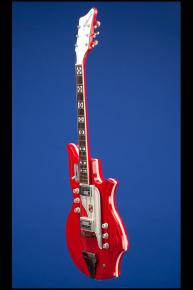The Map of The USA in Vermillion Red.
This asymmetrical double-cutaway, 14 3/4 inch wide and 1 3/4 inch thick, fiberglass bodied guitar weighs just 7.70 lbs. Two-piece molded (0.20 inch thick) vermillion red colored 'res-o-glass' body in the shape of a map of the USA with pointed bass horn corresponding to Maine, pointed treble horn corresponding to Florida, first treble waist cutaway corresponding to Alabama/Missouri and Louisiana. Second treble waist cutaway corresponding to Texas/New Mexico and Arizona. Lower edge corresponding to California and top waist corresponding to Minnesota/Michigan and New York. The top and the bottom (with a center edging of white rubber) held together with four screws entering from the back, going through four polystyrene blocks and then into four 1 1/4 inch square maple blocks which are glued to the upper inside of the body. A fifth securing screw through the strap-button which goes through the tailpiece (into the center maple block). Two maple center blocks, sandwiched together and measuring 17 1/4 inches in length, and a total of 1 1/2 inches in depth, running from the neck to the tail end of the body. Bolt-on (two bolts and a neck adjustment screw) wooden neck finished in vermillion red with a 24 3/4 scale length and a wonderful medium-to-thick profile. Asymmetrical peghead, longer on treble side with "National" logo in raised silver plastic and white veneer peghead face with edges beveled to show side black line. Individual Grover Roto-matic tuners with half moon shaped metal buttons. Small rectangular metal plate with rounded edges, engraved with serial number "T 68492". Single-bound Brazilian rosewood fretboard with 20 original medium frets and pearloid 'diamond enclosed by butterfly' position marker inlays and black dot side markers. Clear lucite pickguard with white backing and "Val / National / Pro" emblem in blue, black and gold, decorated with parallel black lines and secured by three screws. Two National 'Standard' single-coil pickups (with six individually adjustable pole-pieces at the top) with outputs of 9.06k and 9.32k. Six controls - three volume on the bass side and three tone on the treble side. Three-way slotted pickup selector switch with cream plastic tip on the bass side. White plastic conical shaped control knobs with ribbed sides and metal tops. Each knob is secured by a single 'grub' screw. Specific nickel-plated tailpiece with 'stairstep' sides, secured to the lower edge by two screws and the lower strap button (all going into the center maple block). Even though this incredible and totally original 'Map' guitar has just one tiny little 'ding' on the top of the bass horn, we still have to give it full mint (9.50) condition rating. Housed in a later black hardshell case with light gray plush lining (9.00)
Formed in 1926, the National String Instrument Corporation was known for making resonator guitars. National united with the Dobro Company in 1932, and eventually became Valco in 1943. Valco manufactured guitars and amps under its own National and Supro brand names, as well as for Gretsch, Silvertone, Oahu, and Airline.
In 1961, Valco came out with an innovative new style of electric guitar that had bodies made from molded res-o-glass… a fiberglass-like substance made by combining polyester resin and glass threads. The most striking of these res-o-glass instruments were National’s map-shaped guitars… including the Glenwood, Val-Pro, and Newport models. The unusual cutaways on these guitars made them resemble a map of the continental United States.
These 1960s map shaped guitars can have a fatal flaw; there is no adjustable truss rod! So if the neck is warped, the map guitar in question is essentially worthless… our example has a perfectly staright neck. In addition, because of the unique shape of the body, having the original case is a *big* deal! Without the original case, the map-shaped guitar is worth far less. Again our example has the original shaped case.
When Valco introduced this line in the 1962 catalog, the top-of-the-line Glenwood 99 was priced at $295 - that was $5 more than a 1962 Gibson SG/Les Paul Standard!















Hey man,Do this beauty will
Hey man,Do this beauty will ya? I've been seeing it a lot on the wall but I can't recall if you've done a video on her yet? Much appreciated!